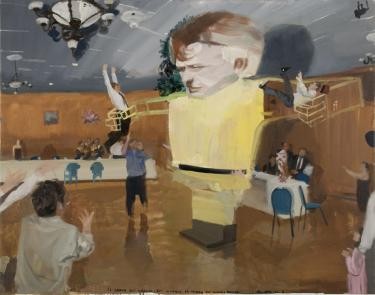Pere Llobera
26 Apr - 31 May 2008
PERE LLOBERA
Memories make life, according to Luis Buñuel. To the Spanish artist Pere Llobera (Barcelona, 1970), memories make art. Just as Buñuel composed his films without any logical structure, Llobera too combines the waves of recollections from his memory in a free and associative manner to produce a painting.
Pere Llobera is first and foremost a painter. But to gain new inspiration, he frequently sets his easel aside, for instance to produce a poetic suit of armour for his youngest daughter, to keep her at that magical age for ever. Or he might make a video of his elder brother playing the drums, to immortalise him as a rock star, even though his brother in fact abandoned his dream of a career as a drummer over twenty years ago. These objects then inspire the artist to make new paintings, which are effectively assembled in the same way. Diverse in the way they are elaborated, the unity of the artworks in Llobera’s first solo exhibition at Galerie Fons Welters lies in their intimate point of departure.
But the painter goes further than this micro-history. References to history and art as well as modern media create a timeless image dominated by incompleteness and melancholy. Llobera’s eclectic approach to combining subjects is matched by an equally free style of painting. Llobera was trained traditionally, and he seems able, with just a few brushstrokes, to present a scene or panorama that appears both abstract and detailed at the same time. Some elements are worked out in precise detail, while others are only indicated in a few contours. He applies the paint thickly and yet leaves some surfaces transparent: just as the memory is sometimes accessible and sometimes impenetrable.
Pere Llobera tries to grasp the nature of reality through his paintings. But what is fact and what is fiction within the fabricated reality of his paintings no longer seems to matter. Facts and fictions merge. Memories are exposed to the now, and enter into new relationships with the past. Nothing is as it was, and nothing is as it seems. From a personal point of departure, Llobera tries to find a larger reality, but he is aware of the many versions of it that exist.
[Laurie Cluitmans]
Memories make life, according to Luis Buñuel. To the Spanish artist Pere Llobera (Barcelona, 1970), memories make art. Just as Buñuel composed his films without any logical structure, Llobera too combines the waves of recollections from his memory in a free and associative manner to produce a painting.
Pere Llobera is first and foremost a painter. But to gain new inspiration, he frequently sets his easel aside, for instance to produce a poetic suit of armour for his youngest daughter, to keep her at that magical age for ever. Or he might make a video of his elder brother playing the drums, to immortalise him as a rock star, even though his brother in fact abandoned his dream of a career as a drummer over twenty years ago. These objects then inspire the artist to make new paintings, which are effectively assembled in the same way. Diverse in the way they are elaborated, the unity of the artworks in Llobera’s first solo exhibition at Galerie Fons Welters lies in their intimate point of departure.
But the painter goes further than this micro-history. References to history and art as well as modern media create a timeless image dominated by incompleteness and melancholy. Llobera’s eclectic approach to combining subjects is matched by an equally free style of painting. Llobera was trained traditionally, and he seems able, with just a few brushstrokes, to present a scene or panorama that appears both abstract and detailed at the same time. Some elements are worked out in precise detail, while others are only indicated in a few contours. He applies the paint thickly and yet leaves some surfaces transparent: just as the memory is sometimes accessible and sometimes impenetrable.
Pere Llobera tries to grasp the nature of reality through his paintings. But what is fact and what is fiction within the fabricated reality of his paintings no longer seems to matter. Facts and fictions merge. Memories are exposed to the now, and enter into new relationships with the past. Nothing is as it was, and nothing is as it seems. From a personal point of departure, Llobera tries to find a larger reality, but he is aware of the many versions of it that exist.
[Laurie Cluitmans]

